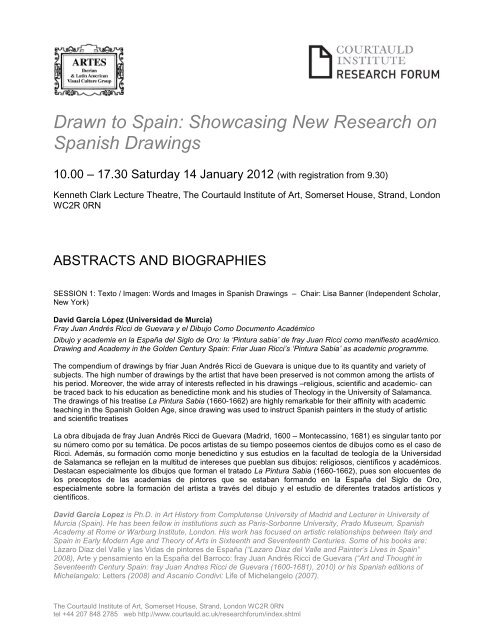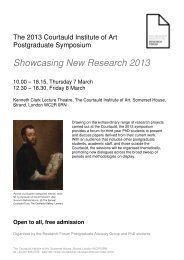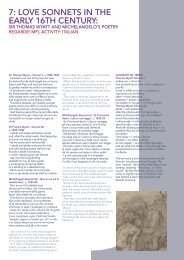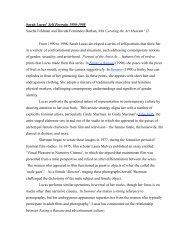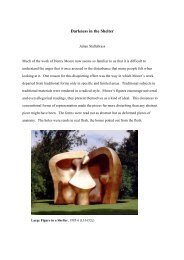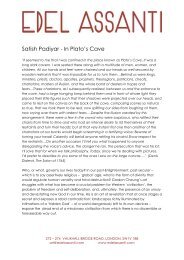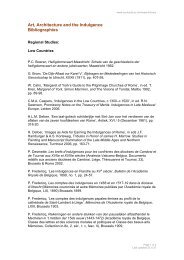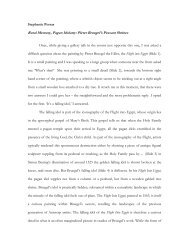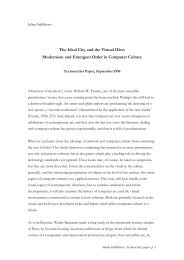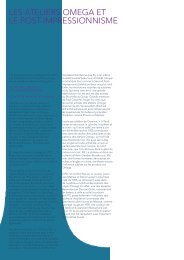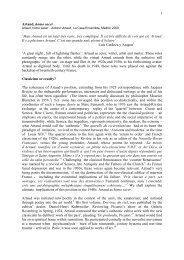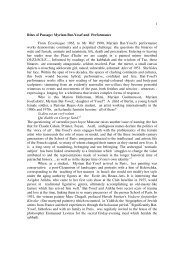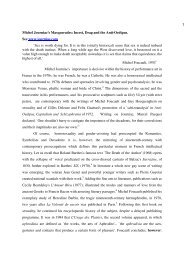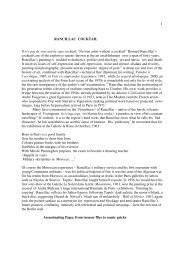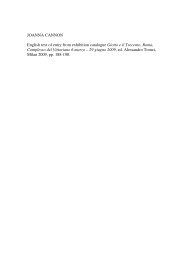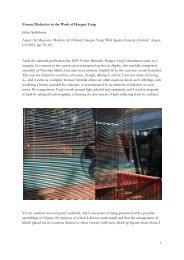Drawn to spain - The Courtauld Institute of Art
Drawn to spain - The Courtauld Institute of Art
Drawn to spain - The Courtauld Institute of Art
Create successful ePaper yourself
Turn your PDF publications into a flip-book with our unique Google optimized e-Paper software.
<strong>Drawn</strong> <strong>to</strong> Spain: Showcasing New Research on<br />
Spanish Drawings<br />
10.00 – 17.30 Saturday 14 January 2012 (with registration from 9.30)<br />
Kenneth Clark Lecture <strong>The</strong>atre, <strong>The</strong> <strong>Courtauld</strong> <strong>Institute</strong> <strong>of</strong> <strong>Art</strong>, Somerset House, Strand, London<br />
WC2R 0RN<br />
ABSTRACTS AND BIOGRAPHIES<br />
SESSION 1: Tex<strong>to</strong> / Imagen: Words and Images in Spanish Drawings – Chair: Lisa Banner (Independent Scholar,<br />
New York)<br />
David García López (Universidad de Murcia)<br />
Fray Juan Andrés Ricci de Guevara y el Dibujo Como Documen<strong>to</strong> Académico<br />
Dibujo y academia en la España del Siglo de Oro: la ‘Pintura sabia’ de fray Juan Ricci como manifies<strong>to</strong> académico.<br />
Drawing and Academy in the Golden Century Spain: Friar Juan Ricci’s ‘Pintura Sabia’ as academic programme.<br />
<strong>The</strong> compendium <strong>of</strong> drawings by friar Juan Andrés Ricci de Guevara is unique due <strong>to</strong> its quantity and variety <strong>of</strong><br />
subjects. <strong>The</strong> high number <strong>of</strong> drawings by the artist that have been preserved is not common among the artists <strong>of</strong><br />
his period. Moreover, the wide array <strong>of</strong> interests reflected in his drawings –religious, scientific and academic- can<br />
be traced back <strong>to</strong> his education as benedictine monk and his studies <strong>of</strong> <strong>The</strong>ology in the University <strong>of</strong> Salamanca.<br />
<strong>The</strong> drawings <strong>of</strong> his treatise La Pintura Sabia (1660-1662) are highly remarkable for their affinity with academic<br />
teaching in the Spanish Golden Age, since drawing was used <strong>to</strong> instruct Spanish painters in the study <strong>of</strong> artistic<br />
and scientific treatises<br />
La obra dibujada de fray Juan Andrés Ricci de Guevara (Madrid, 1600 – Montecassino, 1681) es singular tan<strong>to</strong> por<br />
su número como por su temática. De pocos artistas de su tiempo poseemos cien<strong>to</strong>s de dibujos como es el caso de<br />
Ricci. Además, su formación como monje benedictino y sus estudios en la facultad de teología de la Universidad<br />
de Salamanca se reflejan en la multitud de intereses que pueblan sus dibujos: religiosos, científicos y académicos.<br />
Destacan especialmente los dibujos que forman el tratado La Pintura Sabia (1660-1662), pues son elocuentes de<br />
los precep<strong>to</strong>s de las academias de pin<strong>to</strong>res que se estaban formando en la España del Siglo de Oro,<br />
especialmente sobre la formación del artista a través del dibujo y el estudio de diferentes tratados artísticos y<br />
científicos.<br />
David Garcia Lopez is Ph.D. in <strong>Art</strong> His<strong>to</strong>ry from Complutense University <strong>of</strong> Madrid and Lecturer in University <strong>of</strong><br />
Murcia (Spain). He has been fellow in institutions such as Paris-Sorbonne University, Prado Museum, Spanish<br />
Academy at Rome or Warburg <strong>Institute</strong>, London. His work has focused on artistic relationships between Italy and<br />
Spain in Early Modern Age and <strong>The</strong>ory <strong>of</strong> <strong>Art</strong>s in Sixteenth and Seventeenth Centuries. Some <strong>of</strong> his books are:<br />
Lázaro Diaz del Valle y las Vidas de pin<strong>to</strong>res de España (“Lazaro Diaz del Valle and Painter’s Lives in Spain”<br />
2008), <strong>Art</strong>e y pensamien<strong>to</strong> en la España del Barroco: fray Juan Andrés Ricci de Guevara (“<strong>Art</strong> and Thought in<br />
Seventeenth Century Spain: fray Juan Andres Ricci de Guevara (1600-1681), 2010) or his Spanish editions <strong>of</strong><br />
Michelangelo: Letters (2008) and Ascanio Condivi: Life <strong>of</strong> Michelangelo (2007).<br />
<strong>The</strong> <strong>Courtauld</strong> <strong>Institute</strong> <strong>of</strong> <strong>Art</strong>, Somerset House, Strand, London WC2R 0RN<br />
tel +44 207 848 2785 web http://www.courtauld.ac.uk/researchforum/index.shtml
José Manuel Barbei<strong>to</strong> (Universidad Politécnica de Madrid)<br />
Conocer un Lenguaje: el Dibujo de Arquitectura<br />
Understanding a Language: Architectural Drawing<br />
This presentation arises from research undertaken on some manuscript volumes in the Archivo Histórico Nacional,<br />
containing detailed records <strong>of</strong> the architectural works undertaken between 1610 and 1625 in the royal palace in<br />
Madrid.<br />
This structure's importance as the administrative seat and court <strong>of</strong> the Habsburg monarchy, and the signficance <strong>of</strong><br />
the works undertaken at that time (the new, spectacular barroque facade), makes this documentation <strong>of</strong> particular<br />
interest. Its minutely detailed information describes the materiality <strong>of</strong> the fabric, with widths, weights, heights, girths<br />
and numbers <strong>of</strong> units. However, <strong>of</strong> greatest interest is that many <strong>of</strong> these descriptive sections are accompanied by<br />
small marginal drawings, a means by which those designing the works determine its form, and with this, the work's<br />
identity. Those drawings <strong>of</strong>fer some images <strong>of</strong> extraordinary value for the study <strong>of</strong> the old Alcázar, which, after the<br />
destructive fire that broke out on Christmas Day, 1734, was completely destroyed <strong>to</strong> make way for the Palacio Real<br />
Nuevo. Furthermore, these images allow more general reflections on the role <strong>of</strong> the classical idiom in architectural<br />
composition <strong>of</strong> the early Baroque, thus permitting an appreciation <strong>of</strong> the reliance placed on this formal language (by<br />
this time a matter <strong>of</strong> routine and confidently handled by architects) when the demands <strong>of</strong> a specific project had <strong>to</strong><br />
be met.<br />
Esta ponencia parte del trabajo de investigación realizado sobre unos libros manuscri<strong>to</strong>s conservados en el<br />
Archivo Histórico Nacional, donde se miden y detallan las obras que entre 1610 y 1625 se llevaron a cabo en el<br />
palacio madrileño.<br />
De la importancia del edificio -sede y corte de la monarquía de los Habsburgo-, y de la de los trabajos que por<br />
en<strong>to</strong>nces en él se realizaban – la nueva y espectacular fachada barroca – se deriva el interés de esta<br />
documentación, que de manera muy minuciosa y pormenorizada describe la materialidad de la fábrica con sus<br />
espesores, alturas, gruesos y número de unidades. Pero lo más interesante es que muchas de esas partidas se<br />
acompañan de unos pequeños dibujos al margen, con los que quienes miden las obras, precisan su forma, y con<br />
ella su identidad. Esos dibujos, perdido el edificio, -demolido después de que un incendio lo asolara en la Navidad<br />
de 1734 para dejar paso al Palacio Real Nuevo-, nos <strong>of</strong>recen unas imágenes extraordinariamente valiosas para el<br />
estudio del antiguo alcázar. Pero además permiten una reflexión más general sobre el papel del lenguaje clásico<br />
en la composición de la arquitectura del primer barroco, que deja ver cuan<strong>to</strong> se confía en este mundo formal, -para<br />
en<strong>to</strong>nces convertido en una rutina conocida y manejada con soltura por los artífices-, a la hora de dar respuesta a<br />
las exigencias del proyec<strong>to</strong>.<br />
José Manuel Barbei<strong>to</strong> is a pr<strong>of</strong>essor at the Escuela Técnica Superior de Arquitectura de Madrid where he has<br />
taught Architectural Composition for more than 30 years. His PhD on the Ancient Alcazar <strong>of</strong> Madrid was awarded<br />
the University medal for the best doc<strong>to</strong>ral dissertation in 1988 and has become a reference work since then. His<br />
main research interests are the Relationship between <strong>Art</strong> and Architecture and the Architecture in the Austrian<br />
Court. In addition <strong>to</strong> his academic work he has specialized on museography, as a cura<strong>to</strong>r and designer <strong>of</strong> over fifty<br />
exhibitions.<br />
SESSION 2: Collecting and Defining Spanish Drawings – Chair: Beni<strong>to</strong> Navarrete (Infraestructuras culturales y<br />
patrimonio del ICAS, Seville)<br />
Marta Cacho Casal (Villa i Tatti, Florence)<br />
Santarelli’s Collection <strong>of</strong> Spanish Drawings at the Uffizi<br />
La colección de dibujos españoles de Emilio Santarelli en los Uffizi<br />
In 1866, the Italian sculp<strong>to</strong>r Emilio Santarelli donated 12,461 sheets <strong>of</strong> Old Master drawings <strong>to</strong> the Uffizi gallery.<br />
According <strong>to</strong> a contemporary catalogue, which followed Santarelli’s own instructions, about 482 were made by<br />
Spanish masters and 230 came with an attribution.<br />
<strong>The</strong> collection <strong>of</strong> Spanish drawings at the Uffizi has not been researched since the Mostra di disegni spagnoli 1972<br />
with a catalogue by Pr<strong>of</strong>essor Pérez Sánchez, although many drawings have travelled <strong>to</strong> exhibitions and have<br />
been studied by specialists in the field. <strong>The</strong> time then seems ripe <strong>to</strong> revise some <strong>of</strong> the original attributions as well<br />
as <strong>to</strong> shed some light on matters <strong>of</strong> provenance and the market for Spanish drawings in the XIX century. <strong>The</strong> paper<br />
will <strong>of</strong>fer new insights in<strong>to</strong> Santarelli’s ways <strong>of</strong> collecting and his ambitions <strong>to</strong> create somehow an ‘Is<strong>to</strong>ria dell’<strong>Art</strong>e’.<br />
<strong>The</strong> <strong>Courtauld</strong> <strong>Institute</strong> <strong>of</strong> <strong>Art</strong>, Somerset House, Strand, London WC2R 0RN<br />
tel +44 207 848 2785 web http://www.courtauld.ac.uk/researchforum/index.shtml
En el año de 1866 el escul<strong>to</strong>r italiano Emilio Santarelli donó 12,461 pliegues de dibujos antiguos a la galería de los<br />
Uffizi. Según un catálogo contemporaneo, que seguía las instrucciones del própio Santarelli, alrededor de 482<br />
habían sido creados por maestros españoles, y de ellos, 230 llevaban una atribución.<br />
La colección de los dibujos españoles en los Uffizi no ha sido investigado desde la Mostra di disegni spagnoli de<br />
1972 con su catálogo preparado por Pr<strong>of</strong>esor Pérez Sánchez, aunque muchos dibujos de la colección han viajado<br />
a exposiciones y han sido estudiados por especialistas en este campo. Por lo tan<strong>to</strong> nos encontramos en un buen<br />
momen<strong>to</strong> tan<strong>to</strong> para revisar algunas de las atribuciones originales como también para arrojar luz sobre temas de<br />
procedencia y el mercado de dibujos españoles en el siglo XIX. Esta presentación <strong>of</strong>recerá nuevas visiones sobre<br />
el coleccionismo de Santarelli y sus ambiciones de crear de cierta manera una "Is<strong>to</strong>ria dell'<strong>Art</strong>e". Igualmente, se<br />
mirará en exte contex<strong>to</strong> a su relación con el escul<strong>to</strong>r francés François-Xavier Fabre y con otros coleccionistas<br />
contemporáneos en Florencia.<br />
Marta Cacho Casal has worked for several years at the Department <strong>of</strong> Prints and Drawings <strong>of</strong> the British Museum<br />
after gaining a PhD from <strong>The</strong> Warburg <strong>Institute</strong>, London. She is presently a fellow at Villa I Tatti, <strong>The</strong> Harvard<br />
University Centre for Italian Studies, Florence. Her latest book, Francisco Pacheco y su Libro de retra<strong>to</strong>s has just<br />
been published and was awarded the first Alfonso E. Pérez Sánchez International Research Prize: Velázquez and<br />
his century.<br />
María López-Fanjul y Díez del Corral (<strong>The</strong> <strong>Courtauld</strong> <strong>Institute</strong> <strong>of</strong> <strong>Art</strong>)<br />
Drawing <strong>The</strong>ory and Collecting in Seventeenth-Century Spain<br />
La teoría del dibujo y el coleccionismo en la España del siglo diecisiete<br />
Drawing and theory have rarely been studied <strong>to</strong>gether in relation <strong>to</strong> Spain and the two concepts have never been<br />
considered within a broader cultural context such as collecting.<br />
<strong>The</strong> birth <strong>of</strong> drawing theory in Spain was linked <strong>to</strong> a new interest in its practice, represented in the founding <strong>of</strong><br />
drawing academies, and <strong>to</strong> a new appreciation <strong>of</strong> its value, exemplified by the rising number <strong>of</strong> drawing collections.<br />
This led <strong>to</strong> a very compartmentalised drawing practice, and the drawing procedure started <strong>to</strong> be categorised in<br />
consecutive steps, which from this point were also named. Carducho, Pacheco, Palomino, and Martínez all<br />
discussed the terms that should be applied. <strong>The</strong>y named the steps followed in every Spanish art workshop with<br />
terms that many artists already were using, and validated them by developing theories on the concept, ways, and<br />
kinds <strong>of</strong> ‘dibujo’. <strong>The</strong>se new terms transcended the simple artistic practice and conquered the world <strong>of</strong> collec<strong>to</strong>rs,<br />
as can be seen in the surviving documents and inven<strong>to</strong>ries.<br />
Modern his<strong>to</strong>riography has <strong>of</strong>ten misused the Spanish seventeenth-century drawing nomenclature. <strong>The</strong> complexity<br />
<strong>of</strong> this subject can easily lead <strong>to</strong> confusion. This difficulty has frequently resulted in the disregarding <strong>of</strong> references<br />
<strong>to</strong> drawings in seventeenth-century documents by mixing them up with paintings and prints. In order <strong>to</strong> provide<br />
common criteria <strong>of</strong> interpretation and a more accurate analysis <strong>of</strong> the Spanish drawing collections, María López-<br />
Fanjul studies in her paper the meaning, circumstances, and complexities <strong>of</strong> the theoreticians’ vocabulary in order<br />
<strong>to</strong> decipher the types <strong>of</strong> drawings hidden behind the entries <strong>of</strong> a seventeenth-century inven<strong>to</strong>ry.<br />
Raramente se ha estudiado el dibujo y la teoría conjuntamente en relación con España, y ambos concep<strong>to</strong>s no se<br />
ha considerado nunca en un contex<strong>to</strong> cultural más ámplio cómo puede ser el coleccionismo.<br />
El nacimien<strong>to</strong> de la teoría del dibujo en España fué vinculado a un nuevo interés en la práctica del mismo,<br />
evidenciado en el establecimien<strong>to</strong> de academias del dibujo, y a una nueva apreciación de su valor, ejemplificado<br />
en el número creciente de colecciones de dibujos. A partir de esos determinantes se desarrollaba una práctica<br />
muy compartamentalizada, y los procedimien<strong>to</strong>s gráficos se ordenaron en unos pasos consecutivos, que a partir<br />
de es<strong>to</strong>, llegaron a ser nomrados con términos precisos. Carducho, Pacheco, Palomino y Martínez <strong>to</strong>dos<br />
comentaron sobre los términos que se deberían emplear. Designaban los pasos seguidos en cada taller artístico<br />
español con términos ya empleados por muchos artistas, y validaron los mismos por el desarrollo de teorías sobre<br />
los concep<strong>to</strong>s, modos y maneras del 'dibujo'. Estas nuevas terminologías trascendieron la sencilla práctica<br />
artística, y conquistaron al mundo de los coleccionistas, como se puede apreciar en los documen<strong>to</strong>s e inventarios<br />
existentes.<br />
A menudo la his<strong>to</strong>riografía moderna ha empleado equivocadamente la nomenclatura del dibujo español del siglo<br />
diecisiete. La complejidad del tema facilmente puede llevar a la confusión. Esta dificultad con frecuencia a<br />
conducido a la indiferencia hacía las referencias documentales del siglo diecisiete, llegando a la confusión de<br />
dibujos con pinturas y grabados. Para poder facilitar un criterio de interpretación común, y un analisís más preciso<br />
de las colecciones españoles de dibujo, María López-Fanjul presenta un estudio del significado, circunstancias y<br />
<strong>The</strong> <strong>Courtauld</strong> <strong>Institute</strong> <strong>of</strong> <strong>Art</strong>, Somerset House, Strand, London WC2R 0RN<br />
tel +44 207 848 2785 web http://www.courtauld.ac.uk/researchforum/index.shtml
complejidad del vocabulario de los teóricos para poder decifrar los tipos de dibujos escondidos entre las<br />
descripciones de un inventario del siglo diecisiete.<br />
María López-Fanjul y Díez del Corral holds a BA, MA and MPhil in <strong>Art</strong> His<strong>to</strong>ry (Universidad Complutense,<br />
Madrid); a MA in Museum and Gallery Management (City University <strong>of</strong> London); and a PhD in the His<strong>to</strong>ry <strong>of</strong> <strong>Art</strong><br />
(<strong>The</strong> <strong>Courtauld</strong> <strong>Institute</strong> <strong>of</strong> <strong>Art</strong>, London), entitled Collecting Italian Drawings in Seventeenth-Century Spain: the<br />
Marqués del Carpio’s Collection. She has worked as his<strong>to</strong>rian and manager for a number <strong>of</strong> cultural institutions,<br />
such the Vic<strong>to</strong>ria & Albert Museum (London), the Fundación La Caixa (Madrid), and the Museo del Prado (Madrid).<br />
She has focused her research on the collecting <strong>of</strong> drawings and on museology.<br />
SESSION 3: Techniques and Realisation <strong>of</strong> Spanish Drawings – Chair: Peter Cherry (Trinity College, Dublin)<br />
Ángel Aterido Fernández (Fundación Ortega y Gasset, Centro de Estudios Internacionales, Toledo)<br />
El Dibujo de Desnudo en el Madrid Postvelazqueño: Modelos y Procedimien<strong>to</strong>s Visuales<br />
Figure Drawing in Madrid after Velázquez: Models and Visual Process<br />
<strong>The</strong> representation <strong>of</strong> the nude is a most singular and paradoxical chapter in the his<strong>to</strong>ry <strong>of</strong> Spanish art in the<br />
Golden Age. In specific reference <strong>to</strong> drawings, while copying from the life was an unavoidable part <strong>of</strong> the education<br />
<strong>of</strong> painters and sculp<strong>to</strong>rs, public exhibition <strong>of</strong> the products <strong>of</strong> such exercises was perceived as a danger from the<br />
point <strong>of</strong> view <strong>of</strong> the church authorities. <strong>The</strong>se particular conditions determined artists' working methods from the<br />
way in which (private) academies were organised <strong>to</strong> the use <strong>of</strong> alternative recourses in which the nude model<br />
played no part in compositional solutions.<br />
This presentation will <strong>of</strong>fer a brief overview <strong>of</strong> the circumstances that framed the making <strong>of</strong> academic drawings. To<br />
this end we will center our attention on a concrete place and time <strong>to</strong> illustrate these circumstances: Madrid in the<br />
final decades <strong>of</strong> the seventeenth century. Painters with access <strong>to</strong> the court or those with access <strong>to</strong> the artistic<br />
meetings held in the <strong>to</strong>wn, equally drew the life model in combination with using prints and sculpture. In many<br />
occasions such practises masquerade with an appearance <strong>of</strong> being studied from the life, as is revealed by the<br />
analysis <strong>of</strong> written sources and extant drawings, which are generally difficult <strong>to</strong> catalogue.<br />
Beyond providing illustrative examples, these new observations also <strong>of</strong>fer a more accurate evaluation <strong>of</strong> the origin<br />
and function <strong>of</strong> [academic] drawings, always viewed within the framework <strong>of</strong> the training and creative process <strong>of</strong><br />
painters <strong>of</strong> this period in Madrid.<br />
La representación del desnudo supone uno de los capítulos más singulares y paradójicos de la his<strong>to</strong>ria del arte<br />
español del Siglo de Oro. En el caso concre<strong>to</strong> del dibujo, mientras la copia del natural era parte ineludible de la<br />
formación de pin<strong>to</strong>res y escul<strong>to</strong>res, la exhibición pública del produc<strong>to</strong> de tales ejercicios resultaba peligrosa a ojos<br />
de las au<strong>to</strong>ridades eclesiásticas. Estas condiciones particulares determinaron los mé<strong>to</strong>dos de trabajo de los<br />
artistas, desde la forma en que se celebraban las academias hasta las soluciones alternativas a la comparecencia<br />
de un modelo vivo a las que hubieron de recurrir.<br />
En esta ocasión se <strong>of</strong>recera una breve visión sobre las circunstancias que marcaron la realización de los dibujos<br />
de academias. Para ello nos centraremos en un momen<strong>to</strong> y lugar concre<strong>to</strong>s para ejemplificarlas: las décadas<br />
finales del siglo XVII en Madrid. Los pin<strong>to</strong>res, ya fuera al amparo de la corte o en las reuniones artísticas<br />
celebradas en la Villa, combinaron los modelos reales con el uso de grabados y esculturas. En múltiples ocasiones<br />
tales procedimien<strong>to</strong>s fueron enmascarados con una apariencia natural, tal y como revela el análisis de las fuentes<br />
escritas y de los propios dibujos conservados, en general de difícil catalogación.<br />
Además de la aportación de ejemplos ilustrativos, estas novedades proporcionan una valoración más ajustada<br />
acerca del origen y función de es<strong>to</strong>s dibujos, siempre en el marco de los procesos creativos y formativos de los<br />
pin<strong>to</strong>res madrileños de esta época.<br />
Angel Aterido holds a PhD in art his<strong>to</strong>ry, specializing in Spanish painting <strong>of</strong> the 17th and 18th centuries. He has<br />
worked in exhibition design, as a writer <strong>of</strong> didactic scripts and edi<strong>to</strong>r. <strong>The</strong>ir investigations have focused on the<br />
problems <strong>of</strong> origin and meaning <strong>of</strong> the work <strong>of</strong> art; the genera; collecting; and the social and pr<strong>of</strong>essional aspects <strong>of</strong><br />
the painters in Madrid. Ha had published articles on artists such Cano, Pereda, Giordano y Velázquez. He has<br />
published El bodegón en la España del siglo de Oro (2002) and, in collaboration, Inventarios de pinturas de Felipe<br />
V e Isabel Farnesio (2004). He has been edi<strong>to</strong>r <strong>of</strong> the documentary corpus <strong>of</strong> Velázquez (2000) and Alonso Cano<br />
(2002); and Scientific Direc<strong>to</strong>r <strong>of</strong> the Velázquez digital project, for CEEH (2011-2012). He is currently Pr<strong>of</strong>essor <strong>of</strong><br />
the Centro de Estudios Internacionales <strong>of</strong> Fundación Ortega y Gasset in Toledo (Spain).<br />
<strong>The</strong> <strong>Courtauld</strong> <strong>Institute</strong> <strong>of</strong> <strong>Art</strong>, Somerset House, Strand, London WC2R 0RN<br />
tel +44 207 848 2785 web http://www.courtauld.ac.uk/researchforum/index.shtml
Rafael Romero and Adelina Illán (ICONO restauración y estudios de pintura de caballete, Madrid)<br />
Nuevos Casos de Detección de Dibujo Subyacente en Obras Andaluzas del Siglo de Oro: Da<strong>to</strong>s Adicionales para<br />
el Esclarecimien<strong>to</strong> de una Cuestión Problemática<br />
New Cases <strong>of</strong> the Detection <strong>of</strong> Underdrawing in Andalusian Works <strong>of</strong> the Golden Age: New Information <strong>to</strong> Clarify a<br />
Problematic Question<br />
<strong>The</strong> recent identification <strong>of</strong> a new underdrawing technique in paintings from Alonso Cano’s later career in Granada,<br />
involving precise lines drawn with a red organic lake oil paint, has led the authors <strong>to</strong> conduct a technical reexamination<br />
<strong>of</strong> several paintings executed in Andalusia in the 17th century. <strong>The</strong> results forthcoming have been<br />
especially revealing in that they have found several graphic techniques for the application <strong>of</strong> an accurate<br />
preliminary drawing. <strong>The</strong>re has also been confirmation <strong>of</strong> the presence <strong>of</strong> the aforementioned red-line drawing on<br />
the Descent <strong>of</strong> Christ from the Cross by An<strong>to</strong>nio del Castillo, dated in 1667. Of special interest is the beautiful<br />
underdrawing, made with a pen or fine brush, on the prepara<strong>to</strong>ry sketch for the Saint Anthony (1670-80), which<br />
was part <strong>of</strong> the collection at the Kaiser Friedrich Museum in Berlin (destroyed in 1945). Dating from the same<br />
period, and probably executed using the same technique, is an preliminary drawing on the Portrait <strong>of</strong> the Venerable<br />
Mother Francisco Dorotea, painted by Cornelis Schut, with there also being a version by Murillo (Seville Cathedral)<br />
based on an engraving by Schut himself.<br />
In addition, this study includes the infrared reflec<strong>to</strong>grams, previously published by the authors, <strong>of</strong> two <strong>of</strong> the<br />
prepara<strong>to</strong>ry sketches for the major series on the his<strong>to</strong>ry <strong>of</strong> the Carthusian Order painted by Vicente Carducho for<br />
the Monastery <strong>of</strong> El Paular (1626-1632).<br />
La reciente identificación de una nueva técnica de dibujo subyacente en obras del periodo de madurez de Alonso<br />
Cano en Granada, mediante precisos trazos realizados con laca orgánica roja, ha llevado a los au<strong>to</strong>res a<br />
reexaminar técnicamente varias pinturas del ámbi<strong>to</strong> andaluz del siglo XVII. Los resultados obtenidos han sido<br />
especialmente reveladores al encontrar diversas técnicas gráficas para establecer un preciso dibujo preliminar. Se<br />
ha confirmado también la presencia del mencionado dibujo de líneas rojas en el Descendimien<strong>to</strong> de la cruz de<br />
An<strong>to</strong>nio del Castillo, fechado en 1667. De especial interés se muestra el bello dibujo, a pluma o pincel fino,<br />
subyacente en el boce<strong>to</strong> prepara<strong>to</strong>rio, para el San An<strong>to</strong>nio de Padua con el Niño (1670-80) que formó parte de la<br />
colección del Kaiser Friederich Museum de Berlín (destruído en 1945). De los mismos momen<strong>to</strong>s, y<br />
probablemente realizado con la misma técnica, se ha observado dibujo preliminar en el Retra<strong>to</strong> de la venerable<br />
madre Francisca Dorotea, pintado por Cornelio Schut, obra de la que también Murillo realizó una versión (Catedral<br />
de Sevilla) a partir de un grabado del mismo Schut.<br />
Este estudio incluye además los reflec<strong>to</strong>gramas infrarrojos, ya publicados anteriormente por los au<strong>to</strong>res, de dos de<br />
los boce<strong>to</strong>s prepara<strong>to</strong>rios para la importante serie sobre la his<strong>to</strong>ria de la orden cartuja realizada por Vicente<br />
Carducho para el monasterio del Paular (1626-1632).<br />
Rafael Romero Asenjo received his BA in Fine <strong>Art</strong>s in painting conservation from Universidad Complutense,<br />
Madrid. He was an intern at <strong>The</strong> <strong>Courtauld</strong> <strong>Institute</strong> <strong>of</strong> <strong>Art</strong>, London and at the J. Paul Getty Museum’s Painting<br />
Conservation Department. He is currently Co-direc<strong>to</strong>r <strong>of</strong> ICONO I&R, private conservation studio since 1999.<br />
Adelina Illán Gutiérrez holds a degree in Conservation at the Centro de Estudios de Restauración de <strong>Art</strong>e, Madrid<br />
(1986-1989), and has since been working as freelance res<strong>to</strong>rer in Toledo, Zamora and Madrid. She is currently Codirec<strong>to</strong>r<br />
<strong>of</strong> ICONO I&R, private conservation studio since 1999. icono.i.r@nova.es<br />
SESSION 4: Sight and Suffering in Drawings by Jusepe de Ribera – Chair: Manuela Mena (Museo Nacional del<br />
Prado, Madrid)<br />
Hannah Friedman (<strong>The</strong> Johns Hopkins University, Baltimore)<br />
Blind Practice and Shining Virtue: on the <strong>The</strong>oretical Implications <strong>of</strong> Jusepe de Ribera’s Drawings<br />
Práctica ciega y virtud resplandeciente: sobre las implicaciones teóricas de los dibujos de Jusepe de Ribera<br />
In Jusepe de Ribera’s drawing Studies <strong>of</strong> Two Ears and <strong>of</strong> a Bat in the Metropolitan Museum <strong>of</strong> <strong>Art</strong>, a bat splays its<br />
wings between two left ears that seem <strong>to</strong> sprout from the page itself. <strong>The</strong> mot<strong>to</strong> “FULGET SEMPER VIRTUS”<br />
(virtue shines forever) beneath the bat contrasts pointedly with the animal's blindness; this disjuncture between<br />
image and text engages the theoretical implications <strong>of</strong> drawing itself, as medium, idea, and crucial component <strong>of</strong><br />
artistic practice. Even as the ears call <strong>to</strong> mind the studies <strong>of</strong> features by Ribera, Odoardo Fialetti, Agostino<br />
Carracci, and Guercino, the notion <strong>of</strong> repetitious drawing practice finds another echo in the blindness <strong>of</strong> the bat,<br />
which evokes theoretical and emblematic representations <strong>of</strong> blind practice and bound theory. This paper will argue<br />
that Ribera’s Studies <strong>of</strong> Two Ears and <strong>of</strong> a Bat plays on the joint questions <strong>of</strong> the reliability <strong>of</strong> the bodily senses and<br />
<strong>of</strong> mimetic representation in art. <strong>The</strong> blindness <strong>of</strong> the bat and the ears’ appearance <strong>of</strong> sensory awareness forge a<br />
<strong>The</strong> <strong>Courtauld</strong> <strong>Institute</strong> <strong>of</strong> <strong>Art</strong>, Somerset House, Strand, London WC2R 0RN<br />
tel +44 207 848 2785 web http://www.courtauld.ac.uk/researchforum/index.shtml
link between this drawing and multiple works across Ribera’s oeuvre in which the artist explores and <strong>of</strong>ten<br />
reformulates the representation <strong>of</strong> sensory experience and the role <strong>of</strong> sight in art. Thus, this drawing is a key<br />
statement in Ribera's groundbreaking formulation <strong>of</strong> what it meant <strong>to</strong> produce art in an age that construed practice<br />
as blind and sight as both the paramount means <strong>of</strong> apprehending the world and as the most potentially spurious <strong>of</strong><br />
the senses, physically, philosophically, and spiritually.<br />
En el dibujo de Jusepe de Ribera Studies <strong>of</strong> Two Ears and <strong>of</strong> a Bat, del Metropolitan Museum <strong>of</strong> <strong>Art</strong>, un murciélago<br />
extiende sus alas entre dos orejas que parecen brotar desde la própia hoja del papel. El lema "FULGET SEMPER<br />
VIRTUS" (la virtud resplandece para siempre) que aparece llamativamente inmediatamente debajo del murciélago<br />
<strong>of</strong>rece un fuerte contraste con la ceguedad del animal; esta desconexión entre la imagen y el tex<strong>to</strong> despierta en el<br />
espectador reflexiones sobre las implicaciones teóricas del dibujo en si, cómo medio, idea y componente<br />
fundamental de la práctica artística. A la vez que las orejas nos recuerdan a los estudios de facciones de Ribera,<br />
Odoardo Fialetti, Agostino Carracci y Guercino, la noción de dibujo repetetivo suena otro eco en la ceguera del<br />
murciélago, que evoca representaciones teoóricas y emblemáticas de práctica ciega y teoría intransigente. En esta<br />
presentación se propondrá que Studies <strong>of</strong> Two Ears and <strong>of</strong> a Bat de Ribera juega con las cuestiones conjuntas de<br />
la fiabilidad de los sentidos corporales, y de la representación mimética en el arte. La ceguera del murciélago y la<br />
aparencia de sensibilización de las orejas forjan un enlace entre este dibujo y obras multiples distribuídos en el<br />
oeuvre de Ribera, en que el artista explora, y con frecuencia re-formula, la representación del ejercicio de los<br />
sentidos, y el papel de la vista en el arte. Asi, se califica este dibujo como una expresión clave en la formulación<br />
pionera que Ribera elaboró de lo que significaba el producir arte en una época en que se interpretaba a la práctica<br />
como ciega y a la vista como el medio principal para aprender el mundo, y a la vez, el más traicionero de los<br />
sentidos, en sus funciónes física, filosófica y espiritual.<br />
Hannah J. Friedman is a fourth-year PhD candidate in the His<strong>to</strong>ry <strong>of</strong> <strong>Art</strong> at the Johns Hopkins University, and is<br />
currently working with Dr Stephen J. Campbell and Dr Felipe Pereda on her doc<strong>to</strong>ral dissertation with the working<br />
title Blind Virtue and the Practice <strong>of</strong> Prophecy in the <strong>Art</strong> <strong>of</strong> Jusepe de Ribera. She holds a Master’s degree from the<br />
Williams College Graduate Program in the His<strong>to</strong>ry <strong>of</strong> <strong>Art</strong>, and a Bachelor’s degree in Modern Languages and<br />
Literatures from Kenyon College.<br />
Edward Payne (<strong>The</strong> <strong>Courtauld</strong> <strong>Institute</strong> <strong>of</strong> <strong>Art</strong>)<br />
<strong>The</strong> Bound Man: Ribera’s Drawings <strong>of</strong> Torture in Context<br />
El hombre atado: Los dibujos de <strong>to</strong>rtura de Ribera en context<br />
<strong>The</strong> bound man is a curious leitmotif throughout Ribera’s œuvre. Present in many <strong>of</strong> his paintings, the bound male<br />
figure is even more prominent in his drawings, a quarter <strong>of</strong> which have been identified as representing men tied <strong>to</strong><br />
trees. With subjects deriving from religion, mythology and contemporary society, these drawings have prompted<br />
various interpretations, from suggesting Ribera’s personal obsessions with violence, <strong>to</strong> defending his general<br />
aesthetic interests in depicting the body in complicated positions.<br />
Taking as its focus <strong>The</strong> <strong>Courtauld</strong> drawing <strong>of</strong> a Man tied <strong>to</strong> a tree, and a figure resting, this paper will challenge and<br />
push these arguments further. It will <strong>of</strong>fer a new reading <strong>of</strong> <strong>The</strong> <strong>Courtauld</strong> sheet, situating it within the context <strong>of</strong><br />
related drawings by the artist. Through reconsidering Ribera’s attitude <strong>to</strong>wards representing the suffering body on<br />
paper, it will be argued that these works reveal his preoccupation with the body as a site (and a sight) <strong>of</strong><br />
complication, with pain as a problem <strong>of</strong> expression, and with drawing as a difficult practice in its own right, involving<br />
both skills <strong>of</strong> imitation and manipulation. Of particular importance will be an analysis <strong>of</strong> the relationship between the<br />
suffering body and the subordinate figure, as well as the satirical under<strong>to</strong>nes implicit in some <strong>of</strong> these deeply<br />
serious drawings.<br />
El hombre atado es tema curioso y que recurre a menudo en la producción artística de Ribera. Identificable en<br />
numerosas obras pintadas, la figura masculina atada se protagoniza aún más en sus dibujos, llegando este tipos<br />
de iconografía a ocupar una cuarta parte de sus dibujos. Con temas <strong>to</strong>mados de la religión, la mi<strong>to</strong>logía y la<br />
sociedad contemporánea, es<strong>to</strong>s dibujos han despertado interpretaciones varias, desde la idea de una obsesión<br />
personal con la violencia por parte del artista, hasta una defensa de sus preocupaciones estéticas en la<br />
representación del cuerpo en posiciones complicadas.<br />
Tomando como su pun<strong>to</strong> de enfoque al dibujo del <strong>Courtauld</strong> Man tied <strong>to</strong> a tree, and a figure resting, en esta<br />
presentación se examinará y cuestionará a es<strong>to</strong>s argumen<strong>to</strong>s. Se <strong>of</strong>recerá una lectura nueva del pliegue del<br />
<strong>Courtauld</strong>, situandolo dentro del contex<strong>to</strong> de otros dibujos relcionados de la mano del artista. Considerando de<br />
una manera nueva la actitud de Ribera hacia la representación sobre papel del cuerpo sufriendo, se explicara que<br />
estas obras revelan su preocupación con el cuerpo cómo lugar y visión de complicación, con el dolor cómo<br />
problema de expresión, y con el própio dibujo como práctica dificul<strong>to</strong>sa, exigiendo tan<strong>to</strong> la habilidad en la imitación<br />
<strong>The</strong> <strong>Courtauld</strong> <strong>Institute</strong> <strong>of</strong> <strong>Art</strong>, Somerset House, Strand, London WC2R 0RN<br />
tel +44 207 848 2785 web http://www.courtauld.ac.uk/researchforum/index.shtml
como en el manejo. De importancia particular es el analisis de la relación entre el hombre que sufre y la figura<br />
menor, como también el <strong>to</strong>no satírico subyacente implíci<strong>to</strong> en algunos de es<strong>to</strong>s pr<strong>of</strong>undamente sérios dibujos.<br />
Edward Payne is a Visiting Lecturer at <strong>The</strong> <strong>Courtauld</strong> <strong>Institute</strong> <strong>of</strong> <strong>Art</strong>. In 2009 he held a Rome Award at <strong>The</strong> British<br />
School at Rome, and in 2007-8 worked as a Print Room Assistant in <strong>The</strong> <strong>Courtauld</strong> Gallery Prints and Drawings<br />
Room. He is now completing his PhD thesis, Violence and Corporeality in the <strong>Art</strong> <strong>of</strong> Jusepe de Ribera, supervised<br />
by Dr Sheila McTighe.<br />
SESSION 5: Space and Place in Drawings by Francisco de Goya – Chair: José Manuel Matilla (Museo Nacional<br />
del Prado, Madrid)<br />
Janis Tomlinson (University <strong>of</strong> Delaware, Newark)<br />
Re-opening Goya’s Album “B”<br />
Volviendo a abrir el Albúm "B" de Goya<br />
For those unfamiliar with the scholarship on Goya’s drawings, the term ‘album’ may be misleading. It does not refer<br />
<strong>to</strong> the kind <strong>of</strong> album in which collec<strong>to</strong>rs, connoisseurs and artists had for centuries preserved their drawings.<br />
Rather, Goya’s eight albums (identified by letters A – H) are groups <strong>of</strong> drawings, unified by medium and support<br />
and sometimes numbered in sequence by the artist. As first defined by Eleanor Sayre in 1958, these albums might<br />
be either collections <strong>of</strong> loose sheets or bound sketchbooks. But Pierre Gassier saw more <strong>to</strong> them, writing in his<br />
1973 catalogue that the order <strong>of</strong> drawings within an album reflected ‘the order in which they were executed’.<br />
<strong>The</strong> examination <strong>of</strong> the surviving sheets from Album B strongly tests the assumption that numerical sequence<br />
reflects chronological development, and supports a thesis that these sheets were ordered, numbered in brush and<br />
wash, and bound after their creation. More compositions than sketches, many <strong>of</strong> them were developed over time,<br />
as Goya added a wash background, or a caption <strong>to</strong> an earlier drawing. Consideration <strong>of</strong> these drawings<br />
independent <strong>of</strong> an assigned order or a predetermined theme (as suggested by the alternative title for album B as<br />
the “Madrid” album) calls attention <strong>to</strong> their full stylistic and thematic breadth. <strong>The</strong>ir range invites comparison not<br />
only with the etchings <strong>of</strong> Los Caprichos, <strong>to</strong> which the album is traditionally linked, but also with works <strong>of</strong> the1790s<br />
and early 1800s. Such parallels mark a trajec<strong>to</strong>ry through the final decade <strong>of</strong> the eighteenth, and possibly in<strong>to</strong> the<br />
early nineteenth, century, <strong>to</strong> invite reconsideration <strong>of</strong> their dating.<br />
Para los que no tienen familiaridad especial con el estudio científico de los dibujos de Goya, el término "álbum"<br />
puede engañar. No se refiere al tipo de álbum utilizados durante siglos por los coleccionistas, conocedores y<br />
artistas para conservar sus dibujos. En cambio, los ocho álbumes de Goya (identificados con las letras A-H)<br />
consisten en grupos de dibujos, unificados por su medio y soporte, y en algunos casos, numerados en secuencia<br />
por el artista. Como indicó Eleanor Sayre en 1958, es<strong>to</strong>s álbumes podrían ser o colecciones de hojas sueltas, o<br />
cuaderno confeccionado precisamente para dibujar. Pero Pierre Gassier vió otras posibilidades, escribiendo en su<br />
catálogo de 1973 que el orden de los dibujos dentro de los álbumes reflejaba "el orden en que fueron ejecutados".<br />
La examinación de los pliegues existentes del Álbum B posa cuestiones grandes sobre la idea de que la secuencia<br />
numérica refleja el desarrollo cronológico, y apoya, en cambio, la tésis de una ordenación, numeración a punta de<br />
pincel, y encuadernación posterior a su creación. Son más bien composiciones que boce<strong>to</strong>s, y muchos de las<br />
imagenes fueron desarrolladas a través de bastante tiempo, según Goya modificó un dibujo anterior con la<br />
aplicación de una aguada sobre el fondo, o una inscripción. La consideración de es<strong>to</strong>s dibujos como creaciones<br />
independientes de un orden o temática determinados (este último sugerido por el título alternativo para Álbum B<br />
como el Álbum de Madrid) despierta una mayor comprensión de su plena importancia temática y estilística. Su<br />
variedad invita comparación no sólo con los aguafuertes de Los Caprichos, con los cuales han sido asociados<br />
tradicionalmente, sino también con obras de los 1790s y principios de los 1800s. Tales paralelos marcan una<br />
trayec<strong>to</strong>ria a través de la última década de los 1700s y posiblemente hasta los primeros años del siglo 19, invitan<br />
una reevaluación de su datación.<br />
Janis Tomlinson is the author <strong>of</strong> several books, articles and reviews on the art <strong>of</strong> Spain and Goya. U.S. cura<strong>to</strong>r for<br />
the exhibition, Goya: Images <strong>of</strong> Women (Museo Nacional del Prado/National Gallery <strong>of</strong> <strong>Art</strong>, Washing<strong>to</strong>n, 2001-2),<br />
she continues <strong>to</strong> write and lecture on the artist. Fellowships from the Woodrow Wilson International Center for<br />
Scholars and the Guggenheim Foundation supported her research on national identity and the his<strong>to</strong>riography <strong>of</strong><br />
art. As Direc<strong>to</strong>r <strong>of</strong> Exhibitions and Cultural Programs at the National Academy <strong>of</strong> Sciences (1999-2003), she<br />
developed a program <strong>of</strong> changing exhibitions exploring the relations among science, imagery and art; as Direc<strong>to</strong>r <strong>of</strong><br />
University Museums at the University <strong>of</strong> Delaware since 2003, she oversees the University collections and<br />
exhibitions.<br />
<strong>The</strong> <strong>Courtauld</strong> <strong>Institute</strong> <strong>of</strong> <strong>Art</strong>, Somerset House, Strand, London WC2R 0RN<br />
tel +44 207 848 2785 web http://www.courtauld.ac.uk/researchforum/index.shtml
Reva Wolf (State University <strong>of</strong> New York at New Paltz)<br />
On the Significance <strong>of</strong> Place in Goya’s Drawings<br />
Sobre la significación del lugar en los dibujos de Goya<br />
<strong>The</strong> evocative settings Goya created in his drawings are at once specific and abstract. His album drawings that<br />
portray the home <strong>of</strong> his youth, Zaragoza, are a case in point. Drawings <strong>of</strong> an Inquisition punishment, a man sewn<br />
inside horse, and a mutilated man – all set in Zaragoza – show Goya’s ingenious use <strong>of</strong> word and image <strong>to</strong><br />
highlight characteristics <strong>of</strong> a specific place. To enrich our understanding <strong>of</strong> these features <strong>of</strong> place, Wolf makes<br />
note <strong>of</strong> an intriguingly direct connection between the drawing (recently rediscovered) <strong>of</strong> a man sewn inside a horse<br />
and a s<strong>to</strong>ry published in an early eighteenth-century anti-papal treatise. Broadening out from this discrete<br />
connection, Wolf considers Goya’s portrayals <strong>of</strong> individualised places in light <strong>of</strong> eighteenth-century developments in<br />
car<strong>to</strong>graphy, geography, and travel writing; Wolf also takes in<strong>to</strong> account the then popular depictions <strong>of</strong> regional<br />
types, as well as theories about the effects <strong>of</strong> the environment on human character. <strong>The</strong>se efforts, and recent<br />
assessments <strong>of</strong> eighteenth-century ideas about place, will be enlisted <strong>to</strong> augment our appreciation <strong>of</strong> Goya’s<br />
achievement in bringing <strong>to</strong>gether, in a remarkable interdependence, the particular and the abstract, Spain and the<br />
world.<br />
Los escenarios creados en los dibujos de Goya son a la vez específicos y abstrac<strong>to</strong>s. Un ejemplo puede<br />
encontrarse en los dibujos que representan a Zaragoza, ciudad de su juventud. Dibujos de un castigo inquisi<strong>to</strong>rial,<br />
un hombre cosido dentro de un caballo, y un hombre mutilado – <strong>to</strong>dos ambientados en Zaragoza – muestran el<br />
ingnioso empleo por Goya de la palabra y la imagen para destacar las caracterísiticas de un lugar específico. Para<br />
enriquecer nuestra comprensión te los rasgos de lugar, Wolf hace nota de una conexión intrigante y directa entre<br />
el dibujo (recién descubier<strong>to</strong>) de un hombre metido dentro de un caballo y suje<strong>to</strong> allí por medio de pun<strong>to</strong>s cosidos,<br />
y un cuen<strong>to</strong> publicado en un tratado anti-papal de principios del siglo dieciocho. Desde esta conexión concreta,<br />
Wolf pasa a una considerat más ámpliamente la representación por Goya de lugares individualizados a la luz de<br />
avances en el siglo dieciocho en la car<strong>to</strong>grafía, la geografía y la literatura de viajes. Igualmente, Wolf reflexiona<br />
sobre las interpretaciones contemporáneas de los tipos regionales, tema popular en aquel en<strong>to</strong>nces, y sobre las<br />
teorías sobre la influencia sobre el carácter humano de su en<strong>to</strong>rno. Es<strong>to</strong>s argumen<strong>to</strong>s, y unos analisis recientes<br />
acerca de las ideas sobre lugar en el siglo dieciocho, se apropian para aumentar nuestra apreciación del logro<br />
insóli<strong>to</strong> de Goya en reunir, con una interdependencia impresionante, lo particular y lo abstrac<strong>to</strong>, España y el<br />
mundo.<br />
Reva Wolf is Pr<strong>of</strong>essor <strong>of</strong> <strong>Art</strong> His<strong>to</strong>ry at the State University <strong>of</strong> New York at New Paltz. Her publications include<br />
Goya and the Satirical Print in England and on the Continent and Andy Warhol, Poetry, and Gossip in the 1960s.<br />
She collaborated on the catalogue <strong>of</strong> the 2010 exhibition <strong>of</strong> Spanish drawings at <strong>The</strong> Frick Collection, New York.<br />
Her recent work focuses on methodology, art and humour, the reception <strong>of</strong> art, and issues <strong>of</strong> appropriation and<br />
authenticity. She has held fellowships at Harvard University and at the <strong>Institute</strong> for Advanced Study, Prince<strong>to</strong>n. Last<br />
year she was a recipient <strong>of</strong> the State University <strong>of</strong> New York Chancellor’s Award for Excellence in Teaching.<br />
SESSION 6: Drawing Conversations in the Twentieth Century – Chair: José de la Mano (José de la Mano Galería<br />
de <strong>Art</strong>e, Madrid)<br />
Mark Stuart-Smith (Birkbeck College, University <strong>of</strong> London)<br />
Spanish Dialogues in the Drawings <strong>of</strong> Juan Muñoz<br />
Diálogos españoles en los dibujos de Juan Muñoz<br />
Although best known for his sculptural installations, the Spanish artist Juan Muñoz (1953-2001) was also a prolific<br />
and brilliantly versatile draughtsman, whose <strong>of</strong>ten provocative and unsettling drawings shadow and overlap with<br />
the concerns <strong>of</strong> his sculptural work.<br />
<strong>The</strong> paper examines two categories <strong>of</strong> drawings by Muñoz in terms <strong>of</strong> the contrasting strategies <strong>of</strong> appropriation<br />
that he deploys <strong>to</strong>wards the work <strong>of</strong> Velázquez and Goya. Ventriloquist Looking at a Double Interior (1988-2001),<br />
which appropriates from Velázquez’s Las Meninas the pic<strong>to</strong>rial construction <strong>of</strong> absence and the gaze, combines<br />
two formal exhibition drawings <strong>of</strong> almost identical interiors and a sculpture <strong>of</strong> a ventriloquist's dummy. <strong>The</strong> dummy<br />
compounds the sense <strong>of</strong> paradoxical implication and visual play <strong>of</strong> absence and displacement in the drawings.<br />
In contrast, a number <strong>of</strong> the sketchbook drawings work both with and against the example <strong>of</strong> Goya. <strong>The</strong>se more<br />
informal drawings tend <strong>to</strong> represent dramatic scenarios in which one or two figures appear <strong>to</strong> act out obscure,<br />
saturnine narratives, <strong>of</strong>ten suggesting voyeurism or violence. <strong>The</strong> relationship with Goya's work will be discussed in<br />
the light <strong>of</strong> what Marina Warner has termed the ‘late grotesque’ <strong>to</strong> illuminate Muñoz's evocation <strong>of</strong> narrative, life<br />
and voice through the drawings. <strong>The</strong> paper explores the ventriloquial character <strong>of</strong> both categories <strong>of</strong> drawing and<br />
shows how the two kinds <strong>of</strong> drawings may be compared as a way <strong>of</strong> reflecting on each other’s absences.<br />
<strong>The</strong> <strong>Courtauld</strong> <strong>Institute</strong> <strong>of</strong> <strong>Art</strong>, Somerset House, Strand, London WC2R 0RN<br />
tel +44 207 848 2785 web http://www.courtauld.ac.uk/researchforum/index.shtml
Conocido mejor por sus instalaciones escultóricas, el artista español Juan Muñoz (1953-2001) fué también<br />
dibujante prolífico y brillantemente versátil, cuyos dibujos, a menudo provocativos e inquietantes, prestan relieve y<br />
<strong>of</strong>recen coincidencia con las preocupaciones de su obra escultórica.<br />
En esta presentación se examinaran dos categorías de los dibujos de Muñoz en términos de las estrategias<br />
contrastantes de apropiación que implementa para con la obra de Velázquez y Goya. Ventriloquist Looking at a<br />
Double Interior (1988 - 2001), que apropia de Las Meninas la construcción pictórica de la ausencia y la mirada,<br />
combina dos dibujos formales de exposición, y una escultura en forma de un maniquí de ventrilocuo. El maniquí<br />
aumenta el ambiente de implicación paradójica y el juego visual de ausencia y desplazamien<strong>to</strong> en es<strong>to</strong>s dibujos.<br />
Por contraste, un número de dibujos del cuaderno funcionan en conjun<strong>to</strong> y también en oposición al ejemplo de<br />
Goya. Es<strong>to</strong>s dibujos más formales tienden a representar escenarios dramáticos en que una o dos figuras aparecen<br />
interpretando narrativas obscuras, saturninas, a menudo sugeriendo temas de voyeurism o violencia. La relación<br />
con la obra de Goya será comentada a la luz de lo definido por Marina Warner "late grotesque" para iluminar la<br />
evocación logrado por Muñoz de narrativa, vida y voz a través de los dibujos. En esta presentación se investiga el<br />
carácter ventriloquial de ambas categorías de dibujos y muestra que los dos tipos de dibujos pueden compararse a<br />
modo de reflexionar sus ausencias, el uno al otro.<br />
Mark Stuart-Smith is in the final year <strong>of</strong> an AHRC-funded PhD in His<strong>to</strong>ry <strong>of</strong> <strong>Art</strong> at Birkbeck College, University <strong>of</strong><br />
London, researching the theme <strong>of</strong> silence in the work <strong>of</strong> the Spanish artist Juan Muñoz (1953-2001). He c<strong>of</strong>ounded<br />
Dandelion, the postgraduate online journal and network based at Birkbeck, which launched in 2010, and<br />
has been a general edi<strong>to</strong>r <strong>of</strong> the journal since 2009. He also lectures at the Department <strong>of</strong> His<strong>to</strong>ry <strong>of</strong> <strong>Art</strong> and<br />
Screen Media at Birkbeck and teaches art for the Westminster Council adult education service.<br />
Lauren Barnes (<strong>The</strong> <strong>Courtauld</strong> <strong>Institute</strong> <strong>of</strong> <strong>Art</strong>)<br />
Picasso, Posters and Prestige: <strong>The</strong> ‘Private’ made ‘Public’ in Picasso’s Drawings for the French Communist Party<br />
Picasso, carteles y prestigio: De "privado" a "público" en los dibujos de Picasso para el Partido Comunista de<br />
Francia<br />
In the period from 1949 <strong>to</strong> 1962, drawings and prints by Picasso featured on posters for the Peace Movement <strong>of</strong><br />
the French Communist Party (PCF), <strong>of</strong> which the artist was a member. In addition, Picasso attended Peace<br />
Congresses and twice created drawings on apartment walls in the cities he visited for this purpose. Previous<br />
analyses <strong>of</strong> the political Picasso have passed over these drawings, focussing simply on Picasso’s membership <strong>of</strong><br />
the party as an element <strong>of</strong> its cultural prestige. This paper seeks <strong>to</strong> reassess the drawings by looking closely at<br />
their possible connotations. <strong>The</strong> clear linearity <strong>of</strong> the drawings did not simply enable them <strong>to</strong> be clearly read or<br />
make then suitable for large, public formats. Instead, these linear drawings played on the constructed ‘Picasso<br />
myth’ that surrounded the artist by the time the works were produced. Referring <strong>to</strong> Roland Barthes’ analysis <strong>of</strong><br />
drawings by Cy Twombly, this paper recognises these drawn lines as comparable <strong>to</strong> the signature or au<strong>to</strong>graph <strong>of</strong><br />
the artist. <strong>The</strong> drawings defy the idea <strong>of</strong> drawing as a private, small-scale pursuit, their distinctive line playing in<strong>to</strong><br />
the PCF’s cult <strong>of</strong> Picasso’s personality and the prestige that his support lent <strong>to</strong> the Party. Despite their author never<br />
relinquishing his Spanish nationality <strong>to</strong> take on French citizenship, the drawings’ deployment for international<br />
political purposes and combination with texts from different languages might be said <strong>to</strong> challenge their national<br />
allegiances, pointing <strong>to</strong> the international reach <strong>of</strong> Picasso’s influence.<br />
En el periodo de 1949 a 1962, dibiujos y grabados de Picasso protagonizaron carteles para el Movimien<strong>to</strong> Pacífico<br />
del Partido Comunista Francés, del cual el artista era miembro. Además, Picasso asistió a los Congresos Pacíficos<br />
y en dos ocasiones realizó dibujos sobre muros de edificios en ciudades a donde acudió concretamente para este<br />
fin. Analisis prévios de Picasso político han pasado por al<strong>to</strong> de es<strong>to</strong>s dibujos, concentrandose simplemente en la<br />
afiliación de Picasso con el partido como un elemen<strong>to</strong> del prestigio cultural del mismo. En esta presentación se<br />
pretende reevaluar los dibujos mediante una examinación detenida de sus posibles conotaciones. El carácter<br />
claramente linear de los dibujos sirvió no sólo a asegurar su lectura, o hacerlos apropiados al espacio público y<br />
grande. Mas bien, es<strong>to</strong>s dibujos lineares hacían referencia al "mi<strong>to</strong> Picasso" construido alrededor del artista ya<br />
antes de las fechas en que los dibujos fueron producidos. Con referencia a los analisis de Roland Barthes de los<br />
dibujos de Cy Twombly, se reconoce que estas lineas dibujadas son comparables a la firma o el au<strong>to</strong>frafía del<br />
artista. Desafian es<strong>to</strong>s dibujos a la idea de el dibujo como actividad privada, a escala pequeña, su línea distinta<br />
haciendo juego con el cul<strong>to</strong> a la personalidad de Picasso construida por el PCF, y el prestigio prestado al partido<br />
por su apoyo. A pesar de que su au<strong>to</strong>r jamás abandonó su nacionalidad española para <strong>to</strong>mar la francesa, la<br />
implementación a fines de política internacional y su combinación con tex<strong>to</strong>s de diferentes idiomas podría formular<br />
un desafío a las alianzas nacionales, apuntando al alcanze internacional de la influencia de Picasso.<br />
<strong>The</strong> <strong>Courtauld</strong> <strong>Institute</strong> <strong>of</strong> <strong>Art</strong>, Somerset House, Strand, London WC2R 0RN<br />
tel +44 207 848 2785 web http://www.courtauld.ac.uk/researchforum/index.shtml
Lauren Barnes graduated from <strong>The</strong> <strong>Courtauld</strong> <strong>Institute</strong> <strong>of</strong> <strong>Art</strong>’s MA in <strong>Art</strong> His<strong>to</strong>ry in July 2011, where she studied<br />
Modernism in Europe with Pr<strong>of</strong>essor Chris<strong>to</strong>pher Green, writing her dissertation on sculptures by Le Corbusier and<br />
Joseph Savina. Before this she completed her BA in <strong>Art</strong> His<strong>to</strong>ry at <strong>The</strong> <strong>Courtauld</strong>. She has curated an exhibition <strong>of</strong><br />
contemporary artists’ maps in Guernsey and, with 20//20 Collective, a show at Bethnal Green Working Men’s Club.<br />
She is co-convenor <strong>of</strong> the session ‘Copies and Translations: Re-placing the Original’ at the Association <strong>of</strong> <strong>Art</strong><br />
His<strong>to</strong>rians Conference 2012.<br />
<strong>The</strong> <strong>Courtauld</strong> <strong>Institute</strong> <strong>of</strong> <strong>Art</strong>, Somerset House, Strand, London WC2R 0RN<br />
tel +44 207 848 2785 web http://www.courtauld.ac.uk/researchforum/index.shtml


